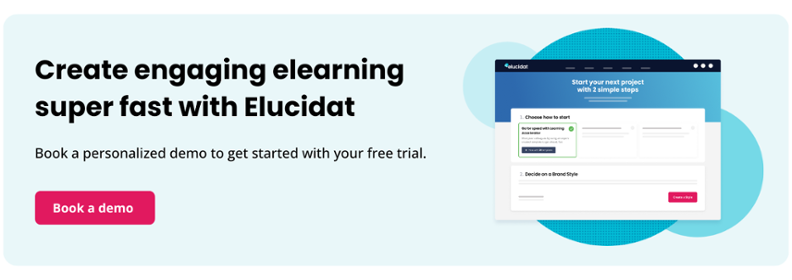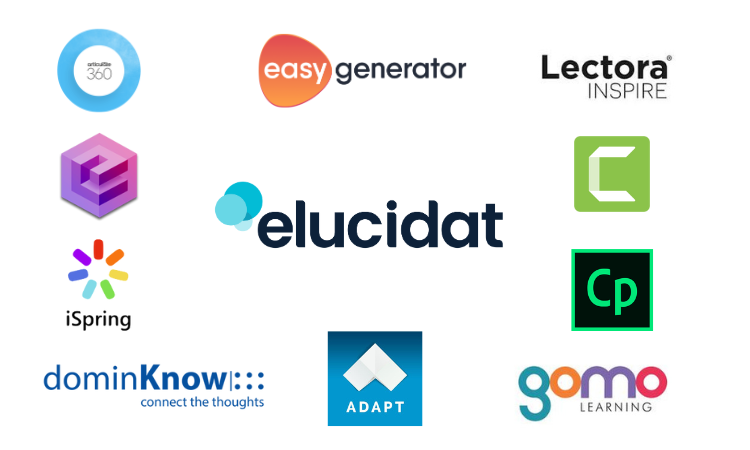6 steps to successfully introduce a new elearning authoring tool to your organization
8 minute read
Implementing a new elearning authoring tool can feel stressful for those in charge of making it happen. It’s a change that affects people and process, after all. So, how do you get your team to rally behind the change, minimize the pain of making the switch and get to those promised benefits as quickly as you can? Be confident your investment is not going to hinder your team, with this great advice from our Head of Customer Success on introducing a new tool smoothly.

A quick overview of the 6 steps
- Be clear about why you’re changing authoring tools
- Pre-empt what the challenges will be
- Find out what tool onboarding is on offer, if any
- Learn how other customers implemented it
- Get to a shareable demo, fast
- Set up your champions
1. Be clear about why you’re changing authoring tools
Why are you moving to a new tool?
Corporate elearning managers approaching the Elucidat team often say they are looking for a more “engaging authoring tool,” something that vastly improves the quality training they can produce in-house. While this is a great reason, it can be helpful to consider other reasons for making the switch. Doing so will help support your business-case and your implementation planning.
What else do you need?
It might be that you need to…
- Boost your in-house production power – meet business demands with a tool that makes it easier to onboard new authors and bring SMEs into the fold
- Make updates more easily – regain control and be able to make rapid updates to your large library of digital learning content, for legislative or other reasons
- Build-in efficiencies at scale – reuse, rebrand, translate and/or collaborate on modules more easily, to deliver large-scale solutions to your organization at less cost
These are common reasons for switching from desktop tools like Storyline or Captivate to a cloud-based authoring tool like Elucidat.
Being crystal clear on your reasoning will enable you to tell the right story about the new tool to your team and stakeholders. It will also give clarity on what “proof points” or milestones you need to build in your implementation plan.
Moreover, it gives you clear grounds for a conversation with your supplier. What can they provide you with to help you get there? An effective platform provider should support you with building your business case, outline what good implementation looks like, and provide guidance, tips and examples to help you get there.
Still weighing up which tools might be best for you? Download our authoring tool comparison template to help with this.
2. Pre-empt where the implementation challenges will be
Whatever your vision, you’ll obviously need to make sure your chosen tool has the features and capabilities to deliver. But what level of change (and risk) does using this tool introduce to your team and business? Don’t just get excited about the shiny new stuff your new tool has to offer. Get real and bottom-out what change it represents to users and to your processes.
Map out your current production process and talk it through
Functional differences are one thing, but process differences are another. Map out, at high-level, your current production process (if you have one). Do different roles, such as reviewers and designers, come into play? If you’re new to online learning, then think about how you currently create face-to-face training.
Get this in front of your platform’s customer success team or equivalent as soon as you can.
Here are some questions new customers ask the Elucidat team – and if they don’t ask, we do it for them!
- How do our current production roles map to the Elucidat roles?
- How best can we use the new assets library? Should we import everything?
- How can we bring in our brand style and ensure consistency across the board?
- Who should take responsibility for releases, do you think?
- What should we do with our old corporate elearning? Convert or keep?
- How will our elearning translations process work in the tool?
- What is best to set up in advance before rolling it out to the wider team?
- And more!
Look for new opportunities to make your process easier
It’s not just about marrying your old process to a new tool. An effective platform partner will see opportunities for you to get your results faster and more efficiently by using their platform. Work with them to reap those.
For example, it may be that you’re shifting to a collaborative, cloud-based platform, meaning reviews, commenting, and edits can all be carried out directly in the tool, not elsewhere. Or perhaps it has in-built author-onboarding, meaning you can open the tool up to SMEs directly.
Is it your only elearning authoring tool?
Shifting whole-heartedly into one new authoring tool versus adding a new one to the mix makes for a very different implementation scenario. Your platform’s customer success team should be able to advise on your desired outcomes and provide you with case studies and practical steps to help you make the switch, in both contexts.
3. Find out what tool onboarding is on offer, if any
How will your team learn a new system, quickly?
This is a key question, and concern, of many looking to make the switch. How your team can get up to speed makes a huge difference to how involved you need to be, how fast you can implement it, and how quickly you can reap the benefits.
Support and onboarding should be part and parcel of your investment, so make sure it’s on offer! Your provider should also be offering more than just tool training as part of this.
For example, with Elucidat, we offer all of our customers:
- Training videos embedded within the platform for any user to consume
- Templates by Elucidat – ready-made corporate elearning Blueprints and a recommendations engine to help novice authors create great online learning materials, fast
- A help center packed with useful guides and support resources
- Live chat support from within the Elucidat app with our industry-leading team
- A dedicated Customer Success Manager whose job it is to help you reach your desired outcomes with Elucidat (such as helping with your implementation)
- Professional services from our in-house team of learning experts who offer coaching and consultancy both at the start of your journey and as you scale in the future.
- Interactice elearning examples to inspire and pave the way, many of which can be gifted into customers’ accounts
“Having never used an authoring tool before, I have found Elucidat to be very intuitive to use and [it] has allowed me to create a lot of engaging content in a short period of time. The onboarding and support are fantastic.”
Phillip Wiedower — Senior Account Executive at Origami Risk LLC
Here’s the minimum you should look for, make sure there’s:
- Expert training available for your tool
- Ongoing support and help available for when it’s needed
- Ready-made templates or even whole structures that can be adapted and used for quick results
4. Learn how other customers implemented it
A successful authoring platform will have had many other large organizations facing the challenge of implementation. How did they do it?
See if your provider can talk you through how other similar organizations have gone through the process for themselves. Find out:
- How long did it take to get up and running?
- Where did they start, and how did they ramp up from there?
- What lessons did they learn?
- What successes are they now experiencing?
Alternatively, check out reviews of the platform in places like elearning Industry, G2 Crowd and Capterra, and take time to explore customer stories the platform openly offers.
5. Work towards milestones and measure successes incrementally
Stay laser-focused on why you are moving to a new tool. It may be weeks or months before you start to see authoring get four times faster, gather enough learner feedback to show that the quality is hitting the mark, and make all those promised releases.
Build-in milestones to your implementation plan and look for ways to test and prove it’s working along the way.
- Speed to create a test course or prototype
- Speed to translate
- Speed to upload onto whatever platforms you use
- Speed to switch brand styles
- Speed to onboard a new author
- Ability to re-use the same course X times
Keep stakeholders up to date and informed on these successes.
“We’ve had courses that were developed for the Canadian medical market and we deployed them in Australia, on a different learning management platform… we did that in less than a week!”
Alexander Brown, L&D Operations Manager at Canopy Growth
5. Get to a shareable demo, fast
Even if you’re working towards a big project, having a new, great-looking example of what your new tool can do is important for getting people on-board. What you produce upfront may even become an in-house template for other teams to use. But as outlined above, it’s not just what you create – it’s the story you can tell about how you made it. How fast, how easy, etc.
If you’re prepped, you might even be able to create a prototype in your free trial!
How to do this
Create a project where the content is relatively “known” to you and has some wow-factor. Perhaps it’s a previous project built in another tool?
Show how you can create this in minutes (or hours depending on your tool choice), on-brand, and ready-to-roll on any device. Look at your provider’s templates and demos to help you get there quickly and make a note of how much time it’s taken you.
With Elucidat, we’d suggest using Premade Templates to get a winning result, super-fast.
6. Set up your champions
It doesn’t have to be you, as a busy learning manager, leading the way. We’d recommend choosing one or two people to be “champions” of your new authoring tool. Let them be “onboarded” by your provider, enable them to get to know the tool through and through, and look to them to set some standards before a wider roll-out.
At Elucidat, we find that customers who empower a small group of champions to organize the back-end can help and speed up the wider implementation. Two weeks of champion-focus time ahead of rolling your authoring tool out to a wider team can pay off later.
If you do want to go for an all-in-one implementation strategy, lean on the tool’s ability to provide consistent styles, templates and collaboration to help everyone get there.
Ready to get started?
Implementing a new tool shouldn’t feel like facing a mountain. Good providers will do the thinking for you, help you break it down into milestones and support you to get there.
Whichever authoring tool you’re planning to use, make sure you speak to your account manager about how they can support you in each of the six areas above. Want to chat with Elucidat about this? Get in touch now.





